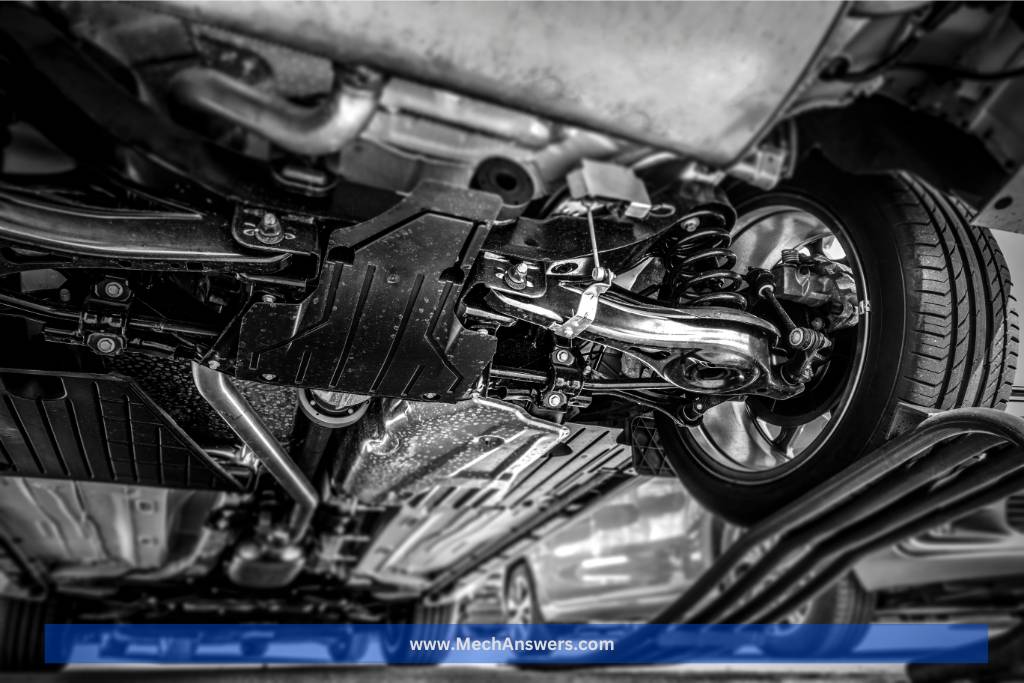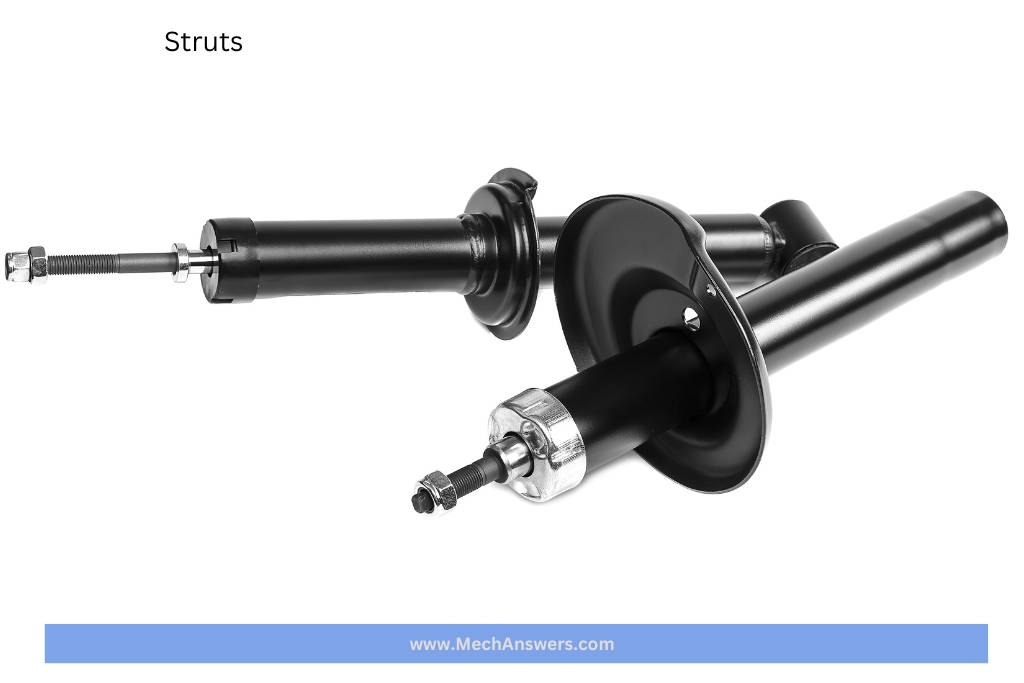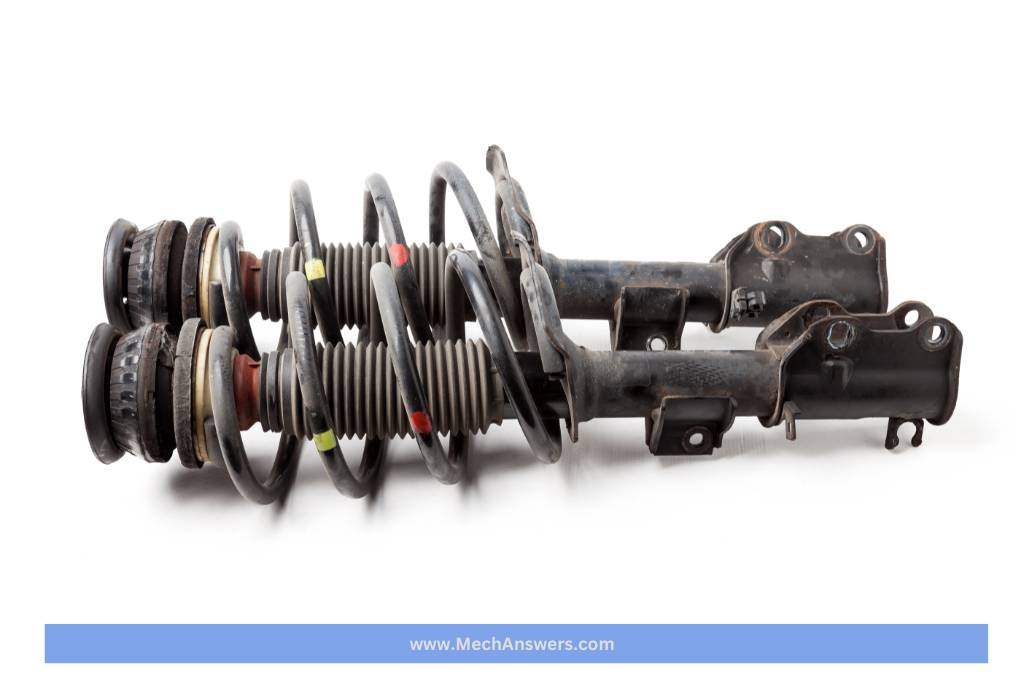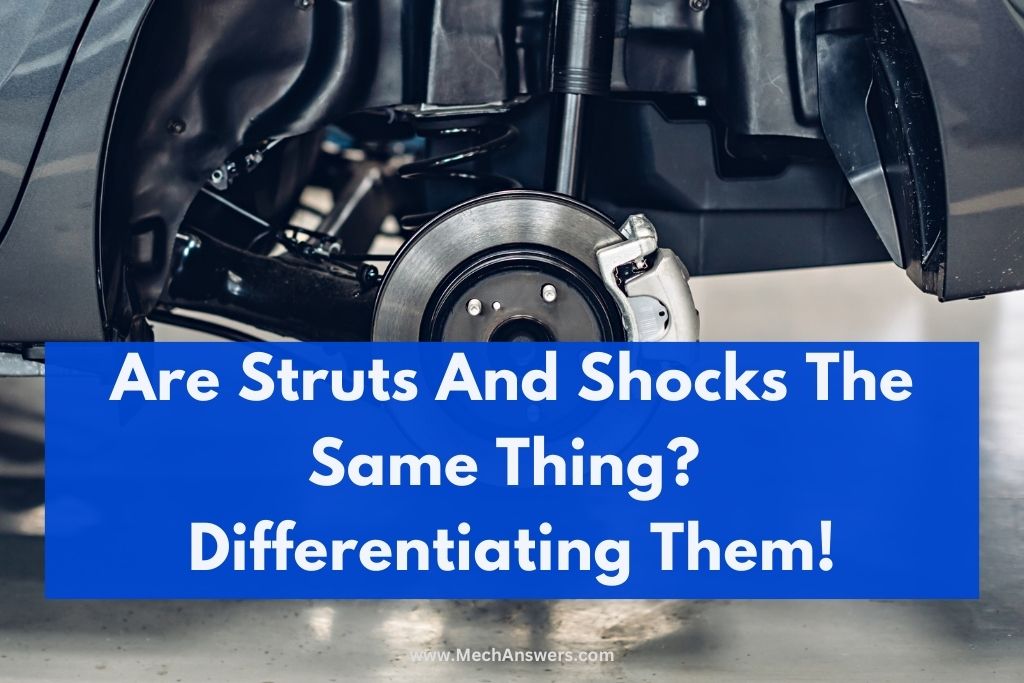Puzzled over the question, “Are Struts And Shocks The Same Thing?” You’re not the only one. This common query among vehicle owners is often a source of confusion. But rest assured, this article is here to demystify it for you.
So, are struts and shocks the same thing? While both parts play crucial roles in your vehicle’s suspension system, they are not the same. Shocks, or shock absorbers, control the movement of the springs and suspension, while struts are a structural part of the suspension system that incorporates the shock absorber.
Why should you keep reading? Understanding the distinction between these two components can significantly impact your vehicle’s maintenance and performance. Through this article, you’ll gain insights that will help you better understand your vehicle’s needs and ensure its optimal performance. Dive in to learn more.

Table of Contents
Are Struts And Shocks The Same Thing?
Essential Takeaway
No, struts and shocks are not the same thing. While both are crucial components of a vehicle’s suspension system, they have distinct designs and serve different functions.
The Core Purpose
At their essence, both shocks and struts are designed to smoothen a vehicle’s ride. They achieve this by dampening the spring oscillations of a car’s suspension system. However, the way they are constructed and the specific roles they play within the system are where their differences lie.
Shock Absorbers Explained
Shock absorbers, commonly referred to as “shocks”, primarily focus on absorbing and dissipating the energy derived from road irregularities.
Their main task is to ensure the tires remain in contact with the road, providing consistent handling and braking. Shocks are essential for controlling the movement of the springs and suspension, preventing excessive bouncing, and ensuring a smooth ride.
Understanding Struts
Struts, while also serving the purpose of absorbing road bumps, are structurally more complex. They are a structural part of the suspension system, often acting as a pivot point for the vehicle’s steering mechanism.
Unlike shocks, struts integrate various suspension parts into one compact assembly, including the coil spring, spring seats, and the shock itself. This integrated design means that struts influence a vehicle’s alignment and overall handling more directly than shocks.
Physical Distinctions
When examining a vehicle, shocks, and struts can often be differentiated by their location and appearance.
Shocks are typically standalone units, while struts are part of an assembly with the coil spring. Shocks can often be found at both the front and rear of a vehicle, while struts are generally located at the front.
Implications for Maintenance
Recognizing the difference between shocks and struts is also crucial when it comes to vehicle maintenance. Due to their integrated nature, struts can be more challenging and expensive to replace compared to shocks.
Regular inspection is advised for both, ensuring they function effectively and maintaining the vehicle’s safety and performance levels.
In wrapping up, shocks and struts, while serving similar fundamental purposes in a vehicle’s suspension system, are distinctly different in design and function. Being aware of these differences aids in understanding vehicle mechanics and ensuring proper maintenance.

Key Differences Of Shocks or Struts And Their Function
Essential Takeaway
While both shocks and struts are vital for a vehicle’s suspension system, shocks primarily control spring and suspension movement, whereas struts are an integral structural component providing vehicle support and housing for the coil spring.
Their distinct designs and functions determine how they contribute to a vehicle’s stability, handling, and ride quality.
Understanding Their Core Roles
Both shocks and struts are components that help maintain tire-road contact by controlling spring and suspension movement. This ensures the vehicle handles bumps and road irregularities efficiently.
However, while shocks only control the movement, struts provide structural support for the vehicle’s suspension and combine multiple components into one unit.
Design Distinctions
Shocks are usually designed as cylindrical containers filled with gas or liquid. Their primary function revolves around absorbing energy, particularly the kinetic energy generated by road bumps and the up-and-down motion of the vehicle.
On the other hand, struts are more elaborate, incorporating elements like the coil spring, shock absorber, and steering knuckle in one single assembly. This makes them more influential in determining how a vehicle handles.
Functionality In The Suspension System
The suspension system’s main job is to ensure the vehicle offers a smooth ride by minimizing the effects of road imperfections. Shocks play their part by absorbing the bounce caused by these imperfections, ensuring tires maintain consistent contact with the road.
Struts, while also performing this absorbing function, offer additional value by being a critical part of the vehicle’s steering system, influencing alignment and stability.
Replacement And Maintenance
Given their different designs and functions, shocks and struts also have varying maintenance needs. Shocks, being simpler, are generally easier and less expensive to replace. Struts, due to their multi-component design, can often demand more extensive work during replacement.
It’s crucial to remember that because struts are part of the steering mechanism, any replacement or maintenance work on them can affect the vehicle’s alignment.
Performance And Ride Quality
A vehicle’s overall ride quality can be significantly impacted by the health and performance of its shocks and struts.
When shocks are worn out or malfunctioning, a vehicle might experience excessive bouncing and a rougher ride. Struts, when compromised, can lead to misalignment, uneven tire wear, and even steering issues.
Both components, therefore, play pivotal roles in ensuring a vehicle remains safe, stable, and comfortable to drive.
In conclusion, while shocks and struts may seem similar, their differences are profound, affecting how vehicles handle, their maintenance needs, and overall safety. Recognizing these differences helps ensure better vehicle care and a deeper understanding of its intricate mechanics.
The Key Differences Between Struts and Shocks
| Key Differences | Struts | Shocks |
|---|---|---|
| Structural Components | Coil spring, shock absorber, top mount, bearing plate | Supports the vehicle’s weight, an integral part of suspension and steering systems |
| Load-bearing Capacity | Does not bear the vehicle’s weight, focuses on controlling and dampening the motion of springs | Provides a more refined and comfortable ride, better control over suspension geometry, and more effective damping performance |
| Impact on Vehicle Stability | More significant role in maintaining stability, especially during cornering and dynamic driving situations | Important for stability, but focuses primarily on controlling spring oscillations |
| Influence on Ride Comfort | Longer service life, more robust construction, and integrated design | Can be a manageable DIY project for those with mechanical experience and the necessary tools |
| Replacement Frequency | More expensive due to the complex design and structural role of the suspension system | Replacement frequency varies depending on factors such as driving conditions, vehicle usage, and overall wear and tear |
| Cost Considerations | Can be a manageable DIY project for those with mechanical experience and the necessary tools | Less expensive to replace, both in terms of parts and labor |
| DIY vs. Professional Installation | Generally best left to professionals, complex and structural role | Can be a manageable DIY project for those with mechanical experience and necessary tools |
This table provides a clear and concise summary of the key differences between struts and shocks, making it easy for readers to understand the information presented in the article.

Signs Of Worn or Damaged Shocks and Struts
Essential Takeaway
Damaged or worn-out shocks and struts manifest in vehicle instability, increased stopping distances, and a noticeably rougher ride. Recognizing these symptoms early can ensure a safer driving experience and prevent more extensive damage to your vehicle.
Vehicle Dips or “Nose Dives” When Stopping
If you notice your vehicle’s front end (or “nose”) dipping significantly when you apply the brakes, this could be a sign that your shocks or struts are worn out. This dipping motion can increase your stopping distance and poses a potential safety hazard, especially in emergency braking situations.
Uneven Tire Wear
Tires should wear out evenly over time. If you start seeing patches of more worn areas, often referred to as “cupping”, it’s an indication that the shocks and struts aren’t holding the tires firmly against the road. Uneven tire wear not only shortens the tire’s lifespan but can also compromise your vehicle’s grip on the road.
Excessive Vehicle Bouncing
A healthy suspension system should efficiently absorb bumps and potholes, ensuring a smooth ride. If you feel your vehicle bouncing excessively or it continues to bounce several times after hitting a bump, it’s a sign that your shocks and struts might be damaged.
Excessive bouncing can make the vehicle harder to control, especially during turns or in windy conditions.
Fluid Leaks
Both shocks and struts are filled with oil. If you see oily or greasy patches on them, it’s a clear indication that they’re leaking and might be malfunctioning. Leaking fluid suggests that the shock or strut isn’t operating at its optimal efficiency and needs immediate attention.
Feeling Every Bump in the Road
A car’s suspension system is designed to provide a buffer between the vehicle and the road’s imperfections. If every little bump or rough patch on the road feels jarring, it could be due to worn-out shocks or struts.
This not only makes for an uncomfortable ride but also means that the vehicle’s suspension system isn’t effectively absorbing the impacts.
Steering Issues
Worn-out struts can lead to issues with the steering system. This can manifest as a feeling of the vehicle “floating”, especially when turning. Any compromise in steering accuracy or feel can have significant implications for vehicle safety, especially at higher speeds or in challenging driving conditions.
In essence, shocks and struts are pivotal to a vehicle’s overall performance and safety. Identifying the signs of wear or damage early on can save on more expensive repairs down the line and ensure the vehicle remains stable, comfortable, and safe on the road.
Regular inspections and timely maintenance can extend the lifespan of these components and offer a more predictable and controlled driving experience.

How Do I Know if I Need Shocks or Struts?
Essential Takeaway
Recognizing the symptoms of worn shocks or struts is critical to vehicle safety and performance. Both components play vital roles in ensuring stability and comfort while driving.
Ride Quality Deterioration
One of the most telling signs is the degradation in ride quality. If your vehicle is excessively bouncy or you feel every bump on the road, it might indicate worn shocks or struts.
Vehicle Sways or Leans
If your car sways during turns or leans forward and backward during acceleration or braking, respectively, it could be a sign. A noticeable change in the handling characteristics of the vehicle often suggests deteriorating shocks or struts.
Uneven Tire Wear
Inspect your tires. If they have uneven or patchy wear, this could suggest that the shocks or struts are not keeping the tires evenly on the road.
Do You Replace Struts with Shocks?
Essential Takeaway
Shocks and struts are distinct components, each designed for specific functions in a vehicle’s suspension system. Replacing one with the other is not advisable.
Distinct Functionalities
Shocks, or shock absorbers, control unwanted spring motion. In contrast, struts are a structural component combining shocks and springs in one unit. Replacing struts with shocks, or vice versa, can disrupt the car’s balance and handling.
Vehicle’s Design
Vehicles are designed to either have shocks or struts. Always replace with the same type that the vehicle originally came with to maintain optimal performance and safety.
Impacts of Incorrect Replacement
Installing the wrong component might not only affect performance but could also be unsafe. It’s essential to understand the specific needs of your vehicle and act accordingly.
When Replacing Struts, What Else Should Be Replaced?
Essential Takeaway
When replacing struts, it’s often advisable to consider changing other related components to ensure the entire suspension system functions optimally. This approach can save both time and future repair costs.
Strut Mounts or Bearings
These components bear the brunt of the strut’s tension and compression. Replacing strut mounts or bearings alongside struts ensures a smoother and noise-free operation.
Springs
While the springs may last longer than the struts, if they show signs of sagging, wear, or damage, it’s wise to replace them simultaneously. New struts combined with old, worn-out springs can lead to suboptimal performance.
Associated Hardware
Often, the smaller hardware pieces, such as bolts and bushings, might get overlooked. However, these parts can corrode or wear out over time and should be replaced alongside the main components to ensure a snug fit and prolonged durability.
Are Struts in the Front or Back?
Essential Takeaway
Struts can be positioned either at the front, the rear, or both, depending on the car’s design. However, a common configuration is front struts and rear shocks.
Design Variations
Different vehicles have different suspension setups. While many cars use front struts paired with rear shocks, others might have struts on both ends or a different combination.
Consulting Your Vehicle Manual
To determine your car’s specific configuration, always refer to the user manual or consult with a mechanic. Being informed about your vehicle’s design helps in making accurate maintenance decisions.
How Often Should Struts Be Replaced?
Essential Takeaway
Struts, like all components, have a lifespan and should be replaced as they wear out. Typically, they last between 50,000 to 100,000 miles, depending on various conditions.
Factors Influencing Strut Lifespan
The longevity of struts depends on several factors including driving habits, road conditions, and the weight carried by the vehicle. It’s not just about mileage; how you drive and where you drive matters.
Regular Inspection is Key
Even if they haven’t reached the high end of their mileage lifespan, struts should be checked regularly for signs of wear or damage. A professional inspection can help determine when replacement is necessary, ensuring safety and optimal performance.
How Often Should Shocks and Struts Be Replaced?
Essential Takeaway
Shocks and struts are integral to a vehicle’s suspension system and typically require replacement every 50,000 to 100,000 miles. However, various real-world factors can influence this general guideline.
Mileage and Other Factors
While mileage is a helpful guideline, other factors such as vehicle load, driving conditions, and road quality can accelerate wear. Routine checks and being attuned to changes in vehicle behavior can guide timely replacements.
Importance of Timely Replacement
Delayed replacement of worn shocks and struts can lead to other issues, from reduced driving comfort to safety hazards. It’s crucial to prioritize their timely replacement to maintain a vehicle’s performance and safety.

Is it OK to Ride with Bad Struts?
Essential Takeaway
Riding with bad struts can jeopardize both vehicle performance and safety. Immediate attention and potential replacement are vital for maintaining optimal driving conditions.
Impaired Vehicle Handling
Bad struts can considerably hinder your vehicle’s stability and handling. When struts deteriorate, the vehicle might sway or bounce more, especially during turns or over bumps, compromising the driving experience.
Safety Concerns
Struts play a crucial role in keeping tires planted on the road. With compromised struts, tire grip can be reduced, especially during adverse conditions or sudden maneuvers. Decreased tire contact can lead to longer stopping distances and increased potential for skidding, posing a significant safety risk.
Increased Wear on Other Components
Bad struts can lead to added stress on other suspension components and the vehicle’s tires. This accelerated wear might result in additional repair costs over time. It’s always more economical and safer to address the issue sooner rather than later.
Is it Expensive to Replace Struts?
Essential Takeaway
The cost of replacing struts can vary widely based on the vehicle model, labor rates, and whether additional components are replaced. Generally, it’s a significant investment, but it’s crucial for maintaining the vehicle’s safety and performance.
Varied Costs by Model
Different car models will have differently priced struts. Luxury vehicles or those with specialized suspension systems might have more expensive components. Always check prices specific to your car model to get a realistic estimate.
Labor Costs
The price of the strut itself is only one aspect. Labor costs can significantly influence the total replacement cost. It’s essential to factor in both parts and labor when budgeting for strut replacement.
Quality Matters
It might be tempting to opt for cheaper aftermarket struts, but the quality can vary. Investing in high-quality struts ensures longevity and optimal vehicle performance. Consider it an investment in your vehicle’s future and your safety.
How Much Do New Struts or Shocks Cost?
Essential Takeaway
The cost of new struts or shocks can vary considerably based on the vehicle’s make, model, and the chosen product’s quality. While it’s an essential maintenance task, it can be a significant expense for many drivers.
Price Range
For many standard vehicles, a strut or shock replacement might cost anywhere from $150 to $500 for each strut or shock. However, luxury vehicles or those with advanced suspension systems might see costs much higher, sometimes exceeding $1,000 for a single component.
Installation Costs
The price of the components is one side of the coin, but labor costs for installation can also be substantial. It’s not uncommon for labor to be equal to or even exceed the parts’ cost, depending on the complexity of the job and the mechanic’s hourly rate.
Total Costs and Consideration
When considering both parts and labor, a complete strut or shock replacement for a standard vehicle could range from $300 to $2,000. It’s imperative to obtain multiple quotes and ensure you’re receiving quality parts and service for your investment.
Related Articles
Read more >> A Comprehensive Guide To A Temporary Fix For Bad Struts
Read more >> When Replacing Shocks What Else Should Be Replaced? (Guide)
Read more >> What Happens If A Strut Breaks While Driving? (Explained!)
Read more >> What Are The 12 Signs Of Rear Wheel Alignment Problems?
Conclusion
While struts and shocks may seem similar, they serve different functions and have distinct structural and functional differences. Understanding these differences is crucial for vehicle owners when making informed decisions regarding the maintenance and replacement of suspension components.
Regular inspections and timely replacement of worn struts and shocks can help ensure optimal vehicle performance, safety, and comfort.
Whether considering aftermarket upgrades or adhering to manufacturer guidelines, it’s essential to select the appropriate components for your vehicle type and intended use to maximize the benefits of your suspension system.
Reference Source:
https://www.monroe.com/technical-resources/shocks-101/shocks-vs-struts.html

